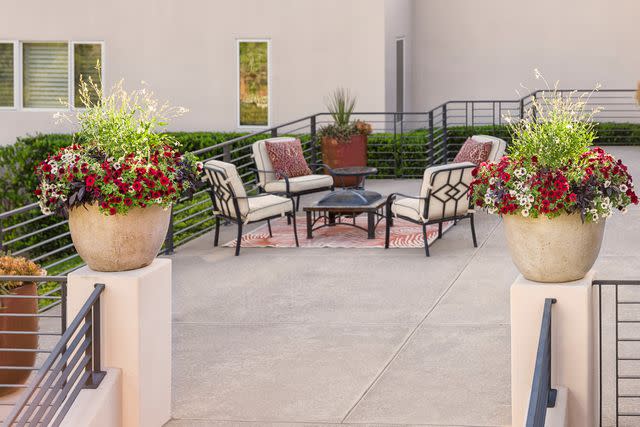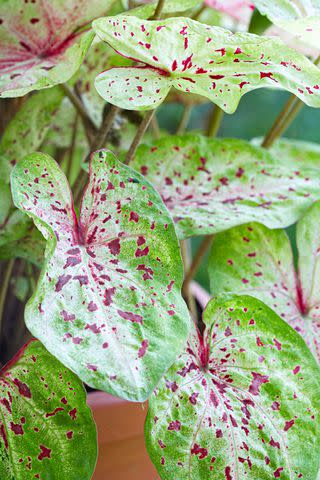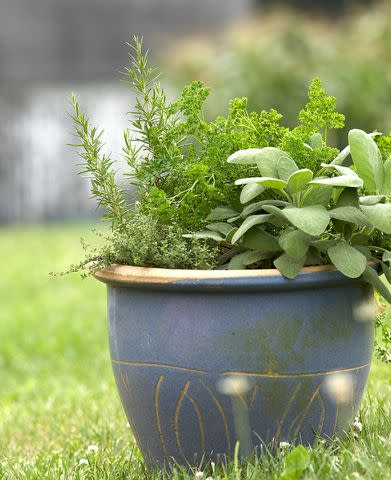10 Best Low-Maintenance Outdoor Plants for Containers in Sun or Shade
These low-maintenance outdoor plants and growing tips will help you create an easy-care container garden.

Better Homes and Gardens
While some plants are generally easier to grow than others, the most low-maintenance outdoor plants for containers are always those that are the right plant for the right place. Matching the plant to the growing conditions will lower effort on your part. This means placing sun-loving container plants in a spot that gets direct sun for most of the day, and keeping shade plants for containers in indirect light. Then, follow these tips to pick the best containers to use, plus a few ideas for low-maintenance outdoor plants to grow in them.

Container Size and Material
One of the main challenges when growing outdoor plants in containers can be the size of the container itself. Large planters are expensive, heavy to move, and require a lot of fill material, which can get pricey. Small containers can stunt growth by restricting the size of the roots, and larger plants in small pots will require more frequent watering.
For a low-maintenance container plant, choose selections appropriate for the size container you will use. A tomato plant can be low maintenance in a large planter–about five gallons or more. If you plant the same tomato in a 12-inch pot, it will be more needy, always wanting water and fertilizer, and won’t grow as big and lush as you’d like.
Container material makes a difference in how much care and maintenance your plants will need. For example, clematis needs cool soil around its roots so avoid putting it in a dark-colored container. Coco coir basket liners look great but drain quicker than plastic. Unglazed terra cotta pots are porous and will help the soil to dry faster–a good thing for plants like rosemary that thrive in drier conditions, but bad for moisture lovers like basil.
Low-Maintenance Container Plants
Huge containers stuffed with gorgeous plants don’t have to be high maintenance. Here are a few outdoor plants for sunny and shady spots to get you started.

Courtesy of Proven Winners
Sun-Loving Plants for Containers
Purple fountain grass (Pennisetum purpureum) is an ornamental grass with spiky, purple foliage that adds height and bulk a low-maintenance container garden. It is heat tolerant and gets quite tall in a garden bed but will be more subdued in a planter.
Supertunias are heat-tolerant hybrids that don’t need much maintenance beyond regular watering. Plant them with a controlled-release fertilizer, and they’ll be happy. No deadheading is required, making these flowering powerhouses an easy choice. They’re available in typical petunia colors, including white, pinks, purples, reds, yellows, and fun multi-colored patterns.
Angelface, and other angelonia hybrids, are vertical stunners perfect for adding taller elements to a flowering container garden. They like the sunshine and tolerate both overwatering and a little neglect. The new angelonia hybrids will keep blooming until frost in fall and are self-cleaning, so no deadheading is required.
Salvias are container garden workhorses, sending up spikes of deep color with a nice mound of foliage below. They are beloved by pollinators, especially hummingbirds. An upright habit with stems that can reach three feet tall and no deadheading makes this long bloomer an excellent addition to a low-maintenance container.

Shade-Loving Container Plants
Rex begonias are excellent foliage plants for partial shade locations. They'll add lots of color and texture, which lasts all season without the hassle of deadheading or pruning. Regular moisture is all they need to be happy.
Caladiums bring brilliant contrasting colors on the same leaf and are great plants to use in the thriller role for a slightly shady location. Heat tolerant and medium height make them a nice pairing with begonias and impatiens.
Fuchsias enjoy partial shade and will cascade over the edge of a pot or basket, providing bright color all summer long in areas with cooler summer temps.

Low-Maintenance Herbs for Outdoor Containers
Many people think herbs are difficult to grow when the opposite is true. If you’re looking for low-maintenance outdoor plants for containers that will survive the weekend without asking your friends to plant sit, traditional herbs are a perfect fit.
Rosemary (Rosemarinus officinalis) can grow to be a medium-sized shrub in a big planter. It’s perennial in warmer climates, but gardeners in cooler locations can bring it inside for the winter. Rosemary thrives on a bit of neglect–it likes soil on the dry side and doesn’t need or want much fertilizer. Sunshine and occasional watering are all you’ll likely need to grow a pot full of fragrant rosemary.
Common thyme (Thymus vulgaris) is easy to grow and has a low upright profile, but errant stems will spill over the side of a container gracefully. It pairs well with rosemary and sage, not only in the kitchen but also in a pot. All three are Mediterranean herbs that do well in drier soil and lower fertility.
Common sage or garden sage (Saliva officinalis) is another low-maintenance herb that does very well in containers. Plant sage with other herbs to create a poultry seasoning pot. Its silvery green foliage contrasts with the sea green of rosemary and the deep green of thyme.
Frequently Asked Questions
How often should outdoor containers be watered?
There’s no getting around that soil in containers dries out more quickly, meaning you’ll need to water as often as daily. If you want to water less frequently, choose low-maintenance outdoor plants that are adapted to drier conditions, such as succulents.
What are some tips for watering outdoor plants in containers?
When creating planters, choose species with similar moisture needs. Mulch the top of the pot, just like in a garden, to keep the soil cooler. Place pots close together and within reach of the hose. Irrigation systems are available to automate the task and can be put on a timer, which can be especially useful for keeping a patio full of planters watered.
For more Better Homes & Gardens news, make sure to sign up for our newsletter!
Read the original article on Better Homes & Gardens.

